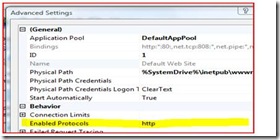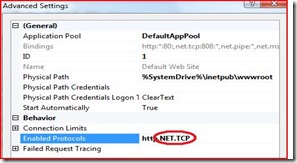Mind the case and space when configuring your protocol bindings inside IIS 7.0 to enable net.tcp
We all are aware that WCF provides a new TCP-based network protocol (net.tcp://) for high performance communication. People who are familiar with this particular protocol will know that for a IIS 7.0 hosted WCF service to utilize this protocol, we need to enable appropriate protocol (namely net.tcp) at the web site and virtual directory level for things to work. Highlighted below is the section where the configurations goes in :
Coming to the issue that I want to share today. I was working on a basic WCF client – service scenario where I had a service hosted on IIS 7.0 over net.tcp protocol. Service binding was as follows
<netTcpBinding><binding name="TransportWithWindows"> <security mode="Message"> <message clientCredentialType ="Windows"/> </security> </binding> </netTcpBinding>
With this simple setting in place, the client was failing with the following exception :
at System.ServiceModel.Channels.ConnectionUpgradeHelper.DecodeFramingFault(ClientFramingDecoder decoder, IConnection connection, Uri via, String contentType, TimeoutHelper& timeoutHelper)
at System.ServiceModel.Channels.ClientFramingDuplexSessionChannel.SendPreamble(IConnection connection, ArraySegment`1 preamble, TimeoutHelper& timeoutHelper) at System.ServiceModel.Channels.ClientFramingDuplexSessionChannel.DuplexConnectionPoolHelper.AcceptPooledConnection(IConnection connection, TimeoutHelper& timeoutHelper) at System.ServiceModel.Channels.ConnectionPoolHelper.EstablishConnection(TimeSpan timeout) at System.ServiceModel.Channels.ClientFramingDuplexSessionChannel.OnOpen(TimeSpan timeout) at System.ServiceModel.Channels.CommunicationObject.Open(TimeSpan timeout) at System.ServiceModel.Channels.ServiceChannel.OnOpen(TimeSpan timeout) at System.ServiceModel.Channels.CommunicationObject.Open(TimeSpan timeout)
That connectivity is the issue out here is evident from the above stack trace. However I had my bindings configured at IIS, Net.Tcp Port Sharing Service was running on my machine, ‘WCF Non-HTTP Activation’ was installed. Where do we look in this case ? Back to the same bindings as highlighted in the image above :
While including the binding information, I had made the mistake of entering it in UPPER CASE instead of lower case (net.tcp). Quite an innocuous error but took quite a while to figure out.
One other point which one should keep in their mind while configuring a protocol binding. DO NOT LEAVE ANY SPACE in between individual bindings.
.NET does not like the following : http, net.tcp. (NOTE A SPACE IN BETWEEN ‘,’ AND ‘n’)
Client will once again fail with a EndpointNotFoundException, while service activation will fail with the following exception :
InvalidOperationException: Could not find a base address that matches scheme net.tcp for the endpoint with binding NetTcpBinding. Registered base address schemes are [http,https].]
Correct : http,net.tcp
Good news is that this little nuance has been resolved with .NET 4.0. Hope these will save some precious time which can be spent elsewhere.

